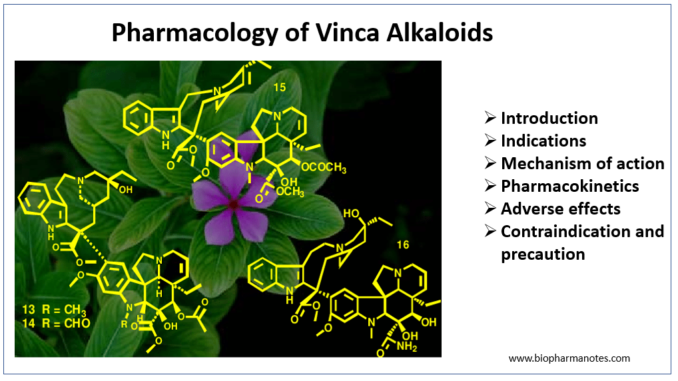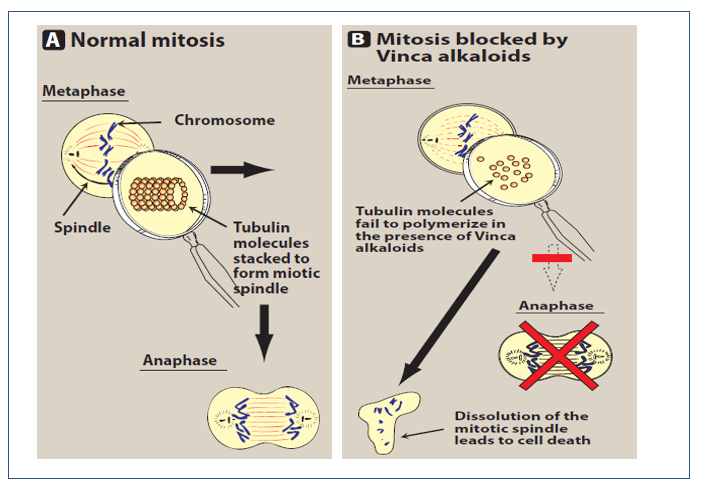
- Vinca alkaloids are isolated from periwinkle plant (Vinca rosea, Catharanthus rosens). They possess anti-mitotic and anti-microtubule properties. Vinca alkaloids are structurally similar but have different therapeutic indications. They are the oldest group of plant alkaloids used to treat cancer. They were discovered for first time in 1950’s by Robert Noble and Charles Beer.
- The four major vinca alkaloids used for clinical purpose are- vincristine, vinblastine, vinorelbine and vindesin. Vinorelbine is semisynthetic derivative. New synthetic vinca alkaloid, vinflunine is also introduced in medical field in 2008.
Indications of Vinca alkaloids
- Vincristine is used in treating acute lymphatic leukemia in children, Wilm’s tumor, Ewing’s soft tissue sarcoma and Hodgkin’s and non- Hodgkin lymphomas. Vinblastine is used in Hodgkin’s lymphoma and other lymphomas. It is used with bleomycin and cisplatin to treat metastatic testicular cancer.
- Vinorelbine is used for non-small cell lung cancer, breast cancer and ovarian cancer either as monotherapy or with cisplatin. It is also used in methotrexate resistant choriocarcinoma and lymphosarcoma.
Mechanism of action of Vinca alkaloids

Figure 1- Mechanism of action of vinca alkaloids (Source- Lippincott Illustrated Reviews of Pharmacology)
- These alkaloids are microtubule damaging agents. Mitotic spindle is required for equal partitioning of DNA into 2 daughter cells during cell division in eukaryotes. It consists of chromatin and microtubule which is composed of tubulin.
- Vinca alkaloids are cell cycle specific. They bind to microtubular protein- βtubulin and inhibit their polymerization with α-tubulin to form microtubules. As intact mitotic spindle is not formed, duplicated chromosome cannot align with division plate. Hence, they block cell cycle in metaphase of mitosis and exert cytotoxic effect.
Pharmacokinetics of Vinca alkaloids
- All vinca alkaloids are administered via IV route. They are not well absorbed orally, are concentrated in liver and are metabolized by CYP 450 enzymes. They are excreted via biliary tract as feces.
- The central and tissue elimination half-lives of vincristine is 1 and 20 hours, vinblastine is 3 and 23 hours and is 1 and 45 hours for vinorelbine, respectively
Adverse Effects
- The severe toxicity of these drugs are mostly related to nervous system. These alkaloids contain chemical groups like indole and di-hydro indole which are also present in psychotropic drugs. Various neuropsychiatric effects include mental depression, ataxia, tremor, peripheral neuropathy and loss of motor function. Vincristine possess cumulative neurotoxic effect compared to other. Inadvertent intrathecal administration of vincristine may cause very dangerous central neurotoxic effects including seizures and irreversible coma. These effects can be managed wither by reducing the dose or by discontinuing the therapy.
- Other toxic effects include alopecia, anorexia, vomiting and severe constipation. Constipation is more frequent with vincristine.
- Vinblastine is potent myelosupressant compared. Hence, it is more toxic to bone marrow. All vinca alkaloids are teratogenic.
Contraindications
- They should not be used by pregnant women, women who are planning for pregnancy or breast-feeding mothers as they cause birth defect.
- Patients who are taking these drugs should not receive any vaccination.
References
- Moudi M, Go R, Yien CYS, Nazre M. Vinca Alkaloids. Int J Prev Med. 2013; 4(11): 1231–1235.
- Pharmacology and Pharmacotherapeutics book. 24th edition.
- Goodman and Gillman’s Manual of Pharmacology and Therapeutics
- Lippincott Illustrated Reviews Pharmacology, 6th edition.
- https://www.ncbi.nlm.nih.gov/books/NBK537122/